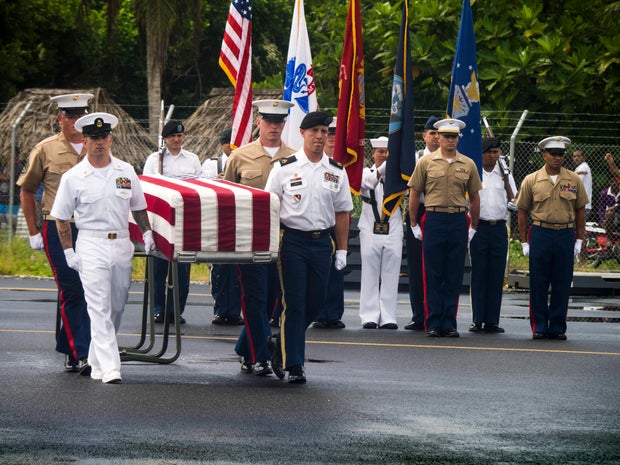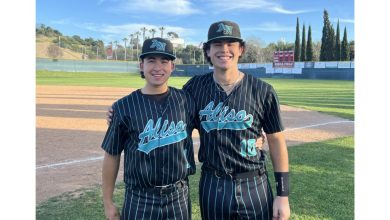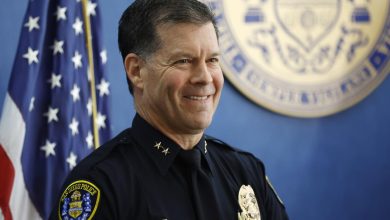
Elsie Thompson, the youngest of seven children, lost two brothers during World War II. His brother Phillip Engesser was taken home to be buried, but his older brother, Marcus Engesserhas just been returned to his California hometown, more than 80 years after his death, thanks to an identification by the Defense POW/MIA Accounting Agency.
Engesser served in Company L of the 31st Infantry Regiment during World War II, operating in the Philippines. He was captured after the U.S. surrender of the Bataan Peninsula in April 1942, DPAA said, and forced to participate in the Bataan Death March before being interned in a notorious prison camp. He died of malaria in September 1942 and his remains were buried in a mass grave at the camp. More than 2,800 American soldiers died at the camp before its liberation in 1945, according to the agency.
Defense POW/MIA Accounting Agency
In 1947, this grave was exhumed and the U.S. Army attempted to identify the soldiers buried there. At the time, most of the remains were considered unidentifiable and they were buried at the Manila American Cemetery and Memorial as unknown. Engesser’s name was engraved on the walls of the deceased in the cemetery.
Thompson, 92, remembers Engesser as a “good” and “beautiful” older brother. It was difficult for her family, she said, never to find her remains. Thompson’s daughter, Joanne Smith, even remembers her grandmother writing a letter to the Army looking for Engesser’s body so he could be buried alongside his family.
“My mother went through a lot because she lost several sons in the war,” Thompson told CBS News. “I think it was pretty hard on my mom. (Marcus) is the only one, we didn’t have any documentation on him.”
In 2018, the unknown remains buried at the Manila American Cemetery and Memorial were again exhumed for study by the DPAA. Mitochondrial DNA analysis, dental and anthropological analysis and other evidence allowed DPAA laboratory scientists to positively identify some of the remains as belonging to Engesser in 2023. Thompson told CBS News that She had been informed of the identification in 2024 and said the fence is “wonderful”.
“It was emotional to hear what was going on with Marky,” Thompson said, adding that she planned to place Engesser’s remains with his mother, brothers and other family members. “It’s been quite an experience.”
What is the Defense POW/MIA Accounting Agency?
Thompson is just one of thousands of people who have had their family members’ remains returned to them through the Defense POW/MIA accounting agency. The agency recorded 158 missing soldiers last year. The identifications bring closure to families and provide fallen soldiers with the opportunity to be buried at home.
The call to identify and recover fallen soldiers was brought to the forefront of national consciousness during the Vietnam War, according to Ashley Wright, public affairs specialist at DPAA. The United States has “always tried to account for our disappearances,” Wright said, starting with the American Graves Registration Command after World War II. That command would attempt to make identifications based on the best scientific data available at the time, Wright said.
However, as science has evolved, so have recoveries and identifications. There are approximately 72,000 soldiers from World War II, approximately 7,500 from the Korean War and more than 1,550 from the Vietnam War who are still missing. But since the first Gulf Wars, there are only six soldiers missing, Wright said, and there are no soldiers missing from the war in Afghanistan. Technology has played an important role in recent conflicts, ensuring that soldiers are identified and returned home.
“It’s just a steep decline with each conflict,” Wright said. “The cases we’re working on right now are not easy dunks, otherwise they would have been solved before. They’re tough cases. They’re tough cases. … We just continue to do what we can to get these families to answer.
How does DPAA identify fallen soldiers?
Wright said “history, diplomacy and science intersect” to help the DPAA lab make identifications.
The process begins with history: Agency researchers and experts begin by combing through archives to learn as much as possible about where a fallen soldier was last seen. Investigation teams will attend the scene to speak to surviving witnesses and examine the area for clues to confirm whether anyone is missing there.
The agency operates in 46 countries, with only one exception: North Korea. Diplomacy is even small enough to connect with individual residents, Wright said, since sometimes a fallen soldier may be missing on what is now private land.
Once DPAA researchers determine they are in the correct location, a recovery mission is sent to the location. Those teams of 15 to 25 people, Wright said, included explosive ordnance disposal experts who could handle live ammunition that might be at the scene. Medical personnel, recovery experts and forensic photographers are also part of these groups, and up to 100 locals may be involved in the physical work of digging and searching for remains. Recovery missions spend 30 to 60 days on the ground, Wright said, before returning to the DPAA laboratory.
Back in the laboratory, several scientific techniques are used to try to identify fallen soldiers. Forensic odontologists, or dentists who can look at medical records and compare them to teeth found in the field, can match dental evidence to the profiles of missing soldiers. Other unique bones, such as the clavicles, are compared. For soldiers missing in the Korean War, experts compare the results of tuberculosis skin tests taken before someone was shipped to the remains found.
The remains are then arranged and x-rayed for further comparison. Other forms of analysis include mitochondrial DNA analysis and isotope analysis, which can determine what a person ate decades ago. This can help identify the remains of American soldiers – who typically ate a corn-based diet – from the remains of locals who might have eaten differently. DPAA also collected comparison DNA from family members, like Thompson.
Once a likely fallen soldier has been identified, family members must provide a reference DNA sample. Finally, a medical examiner will sign a report establishing the identification, and the department’s emergency services officers will then contact family members for a full briefing.
The process is laborious and long. Families can spend decades wondering what happened to their loved one, Wright said, as does Thompson.
“Every case is different and faces its own challenges, and every case is special,” Wright said. “In each of these cases, there is a family member. Each of them has a comrade-in-arms who still wonders what happened to them. This number is certainly not lost on us, in one way or another. of another.”
Department of Defense/William Dasher
Ending Families
Wright said the DPAA’s goal is to bring closure to family members and loved ones like Thompson and Smith. Once family members are notified of their loved one’s identification, the military works with families to conduct a burial with full military honors.
“Even if we found and identified just one tooth, they would get full military honors because they made that ultimate sacrifice,” Wright said.
Smith said the closure has been “incredible” for her family and said she was honored that her uncle would receive a full military funeral. She said she and Thompson might meet the plane carrying Engesser’s remains to California on the tarmac. They also received the Engesser medals.
“My grandmother went through so much…After all these years, to come full circle, to see (Engesser) come home and be buried with his mother, it means a lot,” Smith said. “I’m so grateful my mother was alive to see this happen. I know it means a lot to her to be reunited with her brother on American soil.”
Grub5







